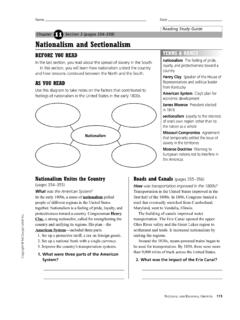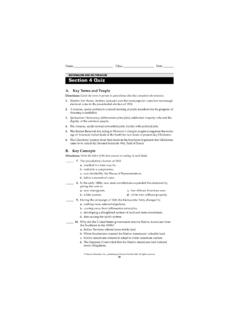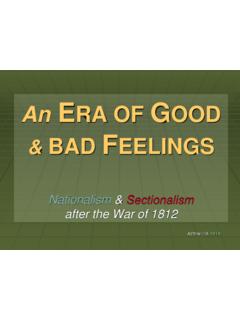Transcription of Grade 8: Nationalism and Sectionalism
1 Grade 8: Nationalism and Sectionalism Stage 1 Desired Results ESTABLISHED GOALS: Competencies: Students will demonstrate the ability to analyze causal relationships in an economic system by explaining the roles of buyers/sellers, innovation, and entrepreneurship in a market economy. Students will demonstrate the ability to analyze the reciprocal relationships among human and physical systems by evaluating geospatial data, historical evidence, economic activity, and political decisions. Students will demonstrate the ability to analyze historical evidence in order to evaluate the influence and impact of perspective. Students will demonstrate the ability to evaluate causal relationships in order to analyze change and continuity over time.
2 Students will demonstrate the ability to analyze and summarize text and integrate knowledge to make meaning of discipline-specific materials. Students will demonstrate the ability to produce coherent and supported writing in order to communicate effectively for a range of discipline-specific tasks, purposes, and audiences. Students will demonstrate the ability to speak purposefully and effectively by strategically making decisions about content, language use, and discourse style. Content Standards Distinguish the powers and responsibilities of citizens, political parties, interest groups, and the media in a variety of governmental and nongovernmental contexts. Examine the origins, purposes, and impact of constitutions, laws, treaties, and international agreements.
3 Explain the powers and limits of the three branches of government, public officials, and bureaucracies at different levels in the United States and in other countries. Assess specific rules and laws (both actual and proposed) as means of addressing public problems. Explain how economic decisions affect the well-being of individuals, businesses, and society. Explain the roles of buyers and sellers in product, labor, and financial markets. Analyze the role of innovation and entrepreneurship in a market economy. Explain why standards of living increase as productivity improves. Explain barriers to trade and how those barriers influence trade among nations. Explain the benefits and the costs of trade policies to Transfer Students will be able to independently use their learning to make informed decisions based upon chronological reasoning and historical perspective.
4 Meaning ENDURING UNDERSTANDINGS Students will understand people demonstrate civic engagement when they address public problems individually and collaboratively and when they maintain, strengthen, and improve communities and societies. in order to act responsibly and effectively, citizens must understand the important institutions of their society and the principles that these institutions are intended to reflect. principles such as equality, freedom, liberty, respect for individual rights, and deliberation apply to both official institutions and informal interactions among citizens. no historical event or development occurs in a vacuum; each one has prior conditions and causes, and each one has consequences.
5 Chronological reasoning requires wrestling with issues of causality, significance, context, and perspective. human-environment interactions are essential aspects of human life in all societies and they occur at local-to-global scales. ESSENTIAL QUESTIONS Why do people choose to make changes in their lives? Acquisition Students will Students will be skilled individuals, businesses, and society Construct maps to represent and explain the spatial patterns of cultural and environmental characteristics. Use maps, satellite images, photographs, and other representations to explain relationships between the locations of places and regions, and changes in their environmental characteristics.
6 Use paper based and electronic mapping and graphing techniques to represent and analyze spatial patterns of different environmental and cultural characteristics. Explain how cultural patterns and economic decisions influence environments and the daily lives of people in both nearby and distant places. Explain how changes in transportation and communication technology influence the spatial connections among human settlements and affect the diffusion of ideas and cultural practices. Analyze how relationships between humans and environments extend or contract spatial patterns of settlement and movement. Evaluate the influences of long-term human-induced environmental change on spatial patterns of conflict and cooperation.
7 Analyze connections among events and developments in broader historical contexts. Classify series of historical events and developments as examples of change and/or continuity. Analyze multiple factors that influenced the perspectives of people during different historical eras. Explain how and why perspectives of people have changed over time. Analyze how people s perspectives influenced what information is available in the historical sources they created. Explain multiple causes and effects of events and developments in the past. Evaluate the relative influence of various causes of events and developments in the past. that the election of 1828 transformed American political campaigns, with the inclusion of mudslinging, election slogans, rallies, buttons, and campaign events.
8 That President Andrew Jackson established the spoils system and his supporters created nominating conventions to select presidential candidates. that President Jackson supported the demands of western settlers and pushed the Indian Removal Act through Congress, forcing the Native Americans to move west. that some Native American groups (the Seminole and Cherokee Nation) resisted relocation. the difference between states rights and the rights of the federal government. that the establishment of a national bank became a divisive issue. that many Americans believed God motivated their will to claim land west. the war with Mexico helped shape southern trade routes for the United States.
9 That each western land claim had its own advantages for settlement. that gold motivated the rapid development of western land claims. that the north and the south had very different communicational advancements. that the North and South developed differently during the first half of the 1800 s. The North built an industrial economy, while the South pursued an agricultural economy based on slavery. that the economies of the North and South influenced the labor force and the development of transportation in the regions. o In the North, immigrants worked in factories. Slavery has mostly disappeared by 1830, but racial prejudice and discrimination remained. Roads, canals, and railroads were built for transportation and shipping.
10 O The South had more small farms than large plantations and most small farmers worked the land themselves. Slavery on large cotton plantations grew due to increased demand for distinguishing powers and responsibilities. examining the origins and impact of laws and agreements. explaining the powers and limitations of governments. assessing how laws address public issues. explaining the impact of economic decisions. explaining the roles of buyers and sellers. analyzing the role of innovation in an economy. explaining the influences that impact trade. explaining the benefits and costs of trade policies. constructing and using maps to explain and analyze relationships and spatial patterns.









